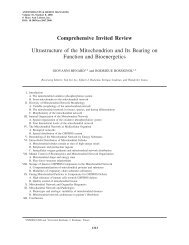MiPsummer Programme pdf - Mitochondrial Physiology Society
MiPsummer Programme pdf - Mitochondrial Physiology Society
MiPsummer Programme pdf - Mitochondrial Physiology Society
You also want an ePaper? Increase the reach of your titles
YUMPU automatically turns print PDFs into web optimized ePapers that Google loves.
54<br />
<strong>Mitochondrial</strong> Dysfunction and Oxidative Stress in Naturally-Occurring Feline Hypertrophic<br />
Cardiomyopathy<br />
L. Christiansen 1 , Flemming Dela 2 , Jørgen Koch 1 , and Takashi Yokota 2<br />
Abstract # 25<br />
1 Department of Veterinary Clinical and Animal Science, University of Copenhagen, Faculty of Health<br />
Sciences, Dyrlægevej 16, 1870 Frederiksberg; 2 Center for Healthy Aging, Department of Biomedical<br />
Sciences, University of Copenhagen, Faculty of Health Sciences, Blegdamsvej 3B, 2200 Copenhagen N<br />
E-mail: lbc@sund.ku.dk<br />
Background: Hypertrophic cardiomyopathy (HCM) is a primary myocardial disease, characterized by<br />
unexplained hypertrophy of the left ventricle. HCM features similar clinical and pathological characteristics<br />
in human beings and cats. <strong>Mitochondrial</strong> dysfunction and oxidative stress are well known to play a role in<br />
heart failure and in various cardiovascular diseases. However, in the pathogenesis of naturally occurring<br />
HCM, the role of mitochondrial function and oxidative stress is not known.<br />
Objectives: The study aimed at evaluating the involvement of mitochondrial dysfunction in naturallyoccurring<br />
feline HCM before severe heart failure develops.<br />
Methods: Cardiac muscle was obtained from nine cats diagnosed with HCM (6 males; 2-10 years old, 6.6 ±<br />
0.8 (mean ± SEM)) and from fifteen age-matched control cats (CON) (4 males; 2-11 years, 4.9 ± 0.7). Highresolution<br />
respirometry was used to measure mitochondrial function in permeabilized, cardiac muscle fibres.<br />
Oxidative stress was assessed by measurements of mitochondrial H 2 O 2 generation and thiobarbituric acid<br />
reactive substances (TBARS).<br />
Results: In heart muscle of HCM cats, complex-I-linked state 3-respiration was significantly decreased (30 ±<br />
6 pmol s -1 mg -1 ) compared to CON (65 ± 7 pmol s -1 mg -1 ) (P=0.002). Fatty acid oxidation with palmitoylcarnitine<br />
and octanoyl-carnitine was significantly decreased in HCM hearts (12 ± 2 pmol s -1 mg -1 ) and (15 ±<br />
1 pmol s -1 mg -1 ) compared to CON (30 ± 2 pmol s -1 mg -1 ) and (45 ± 5 pmol s -1 mg -1 ), respectively<br />
(P=0,002 and P=0.0001). <strong>Mitochondrial</strong> H 2 O 2 generation during state 3, with complex I-linked substrates,<br />
was significantly higher in HCM hearts compared to CON (P



